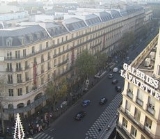
Haussmann's renovation of Paris
Encyclopedia

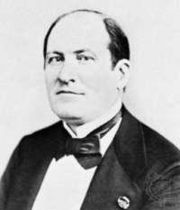
Paris
Paris is the capital and largest city in France, situated on the river Seine, in northern France, at the heart of the Île-de-France region...
commissioned by Napoléon III and led by the Seine prefect
Préfet
A prefect in France is the State's representative in a department or region. Sub-prefects are responsible for the subdivisions of departments, arrondissements...
, Baron Georges-Eugène Haussmann, between 1853 and 1870. Though work continued until the end of the 19th century, well after the Second Empire
Second French Empire
The Second French Empire or French Empire was the Imperial Bonapartist regime of Napoleon III from 1852 to 1870, between the Second Republic and the Third Republic, in France.-Rule of Napoleon III:...
's demise in 1870, it is often referred to as the "Second Empire reforms".
The project encompassed all aspects of urban planning
Urban planning
Urban planning incorporates areas such as economics, design, ecology, sociology, geography, law, political science, and statistics to guide and ensure the orderly development of settlements and communities....
, both in the centre of Paris and in the surrounding districts: streets and boulevards, regulations imposed on facades of buildings, public parks, sewers and water works, city facilities, and public monuments. The planning was influenced by many factors, not the least of which was the city's history of street revolutions.
Haussmann's approach to urban planning was strongly criticised by some of his contemporaries, ignored for a good part of the twentieth century, but later re-evaluated when modernist
Modern architecture
Modern architecture is generally characterized by simplification of form and creation of ornament from the structure and theme of the building. It is a term applied to an overarching movement, with its exact definition and scope varying widely...
approaches to urban planning became discredited. His restructuring of Paris gave the city its present form; its long, straight, wide boulevards with their cafés and shops determined a new type of urban scenario and have had a profound influence on the everyday lives of Parisians. Haussmann's boulevards established the foundation of what is today the popular representation of the French capital around the world, cutting through the old Paris of dense and irregular medieval alleyways into a more rationally-designed city with wide avenues and open spaces which extended outwards far beyond the old city limits.
A medieval capital is modernised
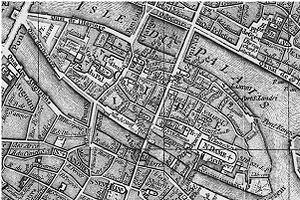
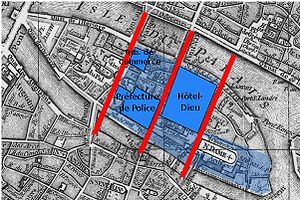
Middle Ages
The Middle Ages is a periodization of European history from the 5th century to the 15th century. The Middle Ages follows the fall of the Western Roman Empire in 476 and precedes the Early Modern Era. It is the middle period of a three-period division of Western history: Classic, Medieval and Modern...
. The narrow interweaving streets and cramped buildings impeded the flow of traffic, resulting in unhealthy conditions that were denounced by the first hygiene scientists. The successive regimes had pushed the outer limits of the city to where they are today, on the Paris périphérique
Périphérique
Périphérique may refer to:* Boulevard Périphérique, a controlled-access dual-carriageway ring road in Paris, France* Périphérique , a ring road circling the French city of Caen...
(beltway), but none of them changed the heart of the capital. From the 1830s to 1860s, it was much the same.
Modernisation of a medieval city
The plan to modernise the city dates back to revolutionary times. In 1794, during the French RevolutionFrench Revolution
The French Revolution , sometimes distinguished as the 'Great French Revolution' , was a period of radical social and political upheaval in France and Europe. The absolute monarchy that had ruled France for centuries collapsed in three years...
, a "Commission of Artists" formed a project suggesting the opening of broader avenues in Paris, with a street making a straight line from Place de la Nation
Place de la Nation
The place de la Nation is a square in Paris, on the border of the 11th and 12th arrondissements...
to the Louvre
Louvre
The Musée du Louvre – in English, the Louvre Museum or simply the Louvre – is one of the world's largest museums, the most visited art museum in the world and a historic monument. A central landmark of Paris, it is located on the Right Bank of the Seine in the 1st arrondissement...
, where the Avenue Victoria is today. It anticipated the east-west main line and attempted to highlight the public monuments.
Napoleon I
Napoleon I of France
Napoleon Bonaparte was a French military and political leader during the latter stages of the French Revolution.As Napoleon I, he was Emperor of the French from 1804 to 1815...
commissioned the construction of a colossal street along the Jardin des Tuileries, the Rue de Rivoli, that extended under the Second Empire up to the Châtelet and the Rue Saint-Antoine; the new street was better adapted to traffic than the street designed by the Commission of Artists. It also served as the basis for a new legal tool: the servitude d'alignement, which prevented real estate owners from renovating or rebuilding beyond a certain line drawn by the administration. However, the law's objective of eventually widening the streets was not borne out.
At the end of the 1830s, prefect Rambuteau realised that the problems regarding traffic and hygiene in the old over-populated districts had become a cause for concern; in accordance with the miasma theory of disease
Miasma theory of disease
The miasma theory held that diseases such as cholera, chlamydia or the Black Death were caused by a miasma , a noxious form of "bad air"....
, then prevailing, it was important to "let air and men circulate". This conclusion stemmed from the 1832 cholera
Cholera
Cholera is an infection of the small intestine that is caused by the bacterium Vibrio cholerae. The main symptoms are profuse watery diarrhea and vomiting. Transmission occurs primarily by drinking or eating water or food that has been contaminated by the diarrhea of an infected person or the feces...
epidemic—which killed 20,000 in Paris out of a total population of 650,000 http://www.amicale-genealogie.org/Histoires_temps-passe/Epidemies/chol01.htm—and the new "social medicine
Public health
Public health is "the science and art of preventing disease, prolonging life and promoting health through the organized efforts and informed choices of society, organizations, public and private, communities and individuals" . It is concerned with threats to health based on population health...
" famously analysed by Michel Foucault
Michel Foucault
Michel Foucault , born Paul-Michel Foucault , was a French philosopher, social theorist and historian of ideas...
(which focused on flux, circulation of air, location of cemeteries
Cemetery
A cemetery is a place in which dead bodies and cremated remains are buried. The term "cemetery" implies that the land is specifically designated as a burying ground. Cemeteries in the Western world are where the final ceremonies of death are observed...
, etc.) Prefect Rambuteau thus drew a new street in the medieval centre of Paris, but the administration had limited powers due to the prevailing rules regulating expropriation
Eminent domain
Eminent domain , compulsory purchase , resumption/compulsory acquisition , or expropriation is an action of the state to seize a citizen's private property, expropriate property, or seize a citizen's rights in property with due monetary compensation, but without the owner's consent...
. A new law passed on 3 May 1841 attempted to solve this issue.
It was with this background that the Second Empire opted for a huge program of expropriation and clearances, much more costly than the servitude d'alignement, but also much more effective.
Louis-Napoleon Bonaparte
Elected president of the Republic of France in 1848, Napoléon III became emperor on 2 December 1852. Under his new rank, Napoléon III decided to modernize Paris after seeing London, a city transformed by the Industrial RevolutionIndustrial Revolution
The Industrial Revolution was a period from the 18th to the 19th century where major changes in agriculture, manufacturing, mining, transportation, and technology had a profound effect on the social, economic and cultural conditions of the times...
, which offered large public parks and a complete sewer
Sanitary sewer
A sanitary sewer is a separate underground carriage system specifically for transporting sewage from houses and commercial buildings to treatment or disposal. Sanitary sewers serving industrial areas also carry industrial wastewater...
system. Inspired by Rambuteau's ideas, and aware of social issues, he wished to improve the housing conditions of the lower class; in some neighbourhoods, the population density reached numbers of 100,000 people/km2 (250,000 people/sq. mile) in conditions of very poor sanitation
Sanitation
Sanitation is the hygienic means of promoting health through prevention of human contact with the hazards of wastes. Hazards can be either physical, microbiological, biological or chemical agents of disease. Wastes that can cause health problems are human and animal feces, solid wastes, domestic...
. The goal was also for public authority to better control a capital where several regimes had been overthrown since 1789. Some real-estate owners demanded large, straight avenues to help troops manoeuvre.
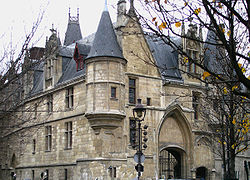
But Napoleon III still had to find a man capable of carrying out a project of such magnitude. He found such a man in Georges Eugène Haussmann, a man of action and rigour, known for being methodical, and he nominated him Prefect of the Seine in 1853. The two men formed an efficient team, the emperor supporting the prefect against his adversaries, and Haussmann showing loyalty in all circumstances, while promoting his own ideas such as a project for Boulevard Saint-Germain
Boulevard Saint-Germain
The Boulevard Saint-Germain is a major street in Paris on the Left Bank of the Seine river. It curves in a 3.5 kilometer arc from the Pont de Sully in the east to the Pont de la Concorde in the west and traverses the 5th, 6th and 7th arrondissements...
.
Such considerable work required many different collaborators. Victor de Persigny, Minister of the Interior, who had introduced Haussmann to Napoleon, was put in charge of the financial aspects, with the help of the Pereire brothers. Jean-Charles Alphand
Jean-Charles Alphand
Jean-Charles Adolphe Alphand, born in 1817 and died in 1891, interred at Père Lachaise Cemetery , was a French Engineer of the Corps of Bridges and Roads...
dealt with the parks and plantations of gardener Jean-Pierre Barillet-Deschamps. Haussmann emphasised the fundamental role of the Paris Map services, led by the architect Deschamps who was in charge of drawing the new avenues and enforcing the construction rules; in this area, "geometry and graphic design play a more important role than architecture itself", said Haussmann,. Other architects took part in the project: Victor Baltard at Les Halles, Théodore Ballu for the Church of Trinity, Gabriel Davioud for the theatres on the Place du Châtelet, and veteran Jacques Ignace Hittorff for the Gare du Nord
Gare du Nord
Paris Nord is one of the six large terminus railway stations of the SNCF mainline network for Paris, France. It offers connections with several urban transportation lines, including Paris Métro and RER...
.
map of PARIS in 1840
Collaboration between public regulation and private initiatives
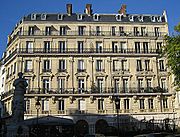
The Haussmann system
In a first step, the state expropriated those owners whose land stood in the way of the renovations. Jules FerryJules Ferry
Jules François Camille Ferry was a French statesman and republican. He was a promoter of laicism and colonial expansion.- Early life :Born in Saint-Dié, in the Vosges département, France, he studied law, and was called to the bar at Paris in 1854, but soon went into politics, contributing to...
condemned this financial issue in a pamphlet published in 1867: Les Comptes fantastiques d'Haussmann (the title is a pun, translating as "The Fantastic Accounts of Haussmann," but homophonic with the title of Jacques Offenbach
Jacques Offenbach
Jacques Offenbach was a Prussian-born French composer, cellist and impresario. He is remembered for his nearly 100 operettas of the 1850s–1870s and his uncompleted opera The Tales of Hoffmann. He was a powerful influence on later composers of the operetta genre, particularly Johann Strauss, Jr....
's opéra comique
Opéra comique
Opéra comique is a genre of French opera that contains spoken dialogue and arias. It emerged out of the popular opéra comiques en vaudevilles of the Fair Theatres of St Germain and St Laurent , which combined existing popular tunes with spoken sections...
, Les Contes d'Hoffmann
Les contes d'Hoffmann
Les contes d'Hoffmann is an opéra by Jacques Offenbach. The French libretto was written by Jules Barbier, based on short stories by E. T. A...
).
Public regulations
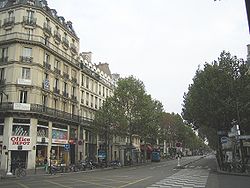
- Expropriation "for purposes of public interest": the city could acquire buildings placed along the avenues to be constructed, whereas earlier it could only acquire the buildings placed directly on the future construction site. This would allow a considerable part of the Île de la CitéÎle de la CitéThe Île de la Cité is one of two remaining natural islands in the Seine within the city of Paris . It is the centre of Paris and the location where the medieval city was refounded....
to be demolished. After 1860, the regime's more progressive stance made expropriations more difficult. - Those who owned buildings were required to clean and refresh the facades every ten years.
- The levelling of the streets of Paris, the buildings' alignments and connections to the sewer were regulated.
The authorities intervened at the same time to regulate the dimensions of buildings and even on the aesthetic aspect of their frontages:
- The 1859 regulations for urban planning in Paris increased the maximum height of buildings from 17.55 meters (57.5 ft) to 20 meters (65.6 ft) in streets wider than 20 meters. The roofs needed to still have a 45 degree incline.
- Construction along the new avenues had to comply with a set of rules regarding outside appearance. Neighbouring buildings had to have their floors at the same height, and the façades' main lines had to be the same. The use of quarryQuarryA quarry is a type of open-pit mine from which rock or minerals are extracted. Quarries are generally used for extracting building materials, such as dimension stone, construction aggregate, riprap, sand, and gravel. They are often collocated with concrete and asphalt plants due to the requirement...
stone was mandatory along these avenues. Paris started to acquire the features of an immense palace.
Already, the central role played by the architects of the roads showed the importance of engineers as civil servants.
The plan unfolds
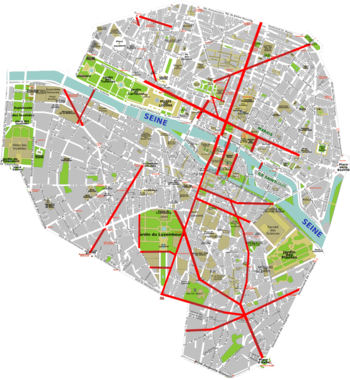
Some of these projects were to continue under the Third Republic
French Third Republic
The French Third Republic was the republican government of France from 1870, when the Second French Empire collapsed due to the French defeat in the Franco-Prussian War, to 1940, when France was overrun by Nazi Germany during World War II, resulting in the German and Italian occupations of France...
, after Haussmann and Napoleon III had stepped down.
A network of large avenues
When Rambuteau cleared the way for the first time in the city's history for a large avenue in the centre of Paris, Parisians were surprised by its width of 13 meters (45 ft). But Haussmann made the Rue Rambuteau a moderate-sized street after creating new avenues up to 30 meters wide (100 ft). To this day, the Haussmann network is still the backbone of Paris's urban body.The north-south and east-west openings
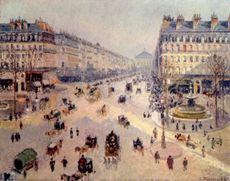
Because of the construction of the North-South line, from boulevard de Sébastopol
Boulevard de Sébastopol
The Boulevard de Sébastopol is an important roadway in Paris, France, which serves to delimit the 1st and 2nd arrondissements from the 3rd and 4th arrondissements of the city....
to Boulevard Saint-Michel
Boulevard Saint-Michel
The Boulevard Saint-Michel is one of the two major streets in the Latin Quarter of Paris . It is a tree-lined boulevard which runs south from the pont Saint-Michel on the Seine river and the Place Saint-Michel, crosses the boulevard Saint-Germain and continues alongside the Sorbonne and the...
, a number of alleyways and dead-ends were cleared from the map. This line included an important intersection near the Châtelet
Place du Châtelet
The Place du Châtelet is a public square in Paris, on the right bank of the river Seine, on the borderline between the 1st and 4th arrondissements...
and the Rue de Rivoli: the Second Empire
Second French Empire
The Second French Empire or French Empire was the Imperial Bonapartist regime of Napoleon III from 1852 to 1870, between the Second Republic and the Third Republic, in France.-Rule of Napoleon III:...
extended it to the rue Saint-Antoine, a street Napoleon I had drawn alongside the Tuileries.
At the same time, Baltard was working on the Halles
Les Halles
Les Halles is an area of Paris, France, located in the 1er arrondissement, just south of the fashionable rue Montorgueil. It is named for the large central wholesale marketplace, which was demolished in 1971, to be replaced with an underground modern shopping precinct, the Forum des Halles...
, a project initiated by Rambuteau, and the Île de la Cité was vastly demolished and transformed. The bridges surrounding were either rebuilt or considerably redone.
Haussmann completed this large intersection with line connecting the first circle of boulevards, such as the rue de Rennes on the left bank and the avenue de l'Opéra
Avenue de l'Opéra
The Avenue de l'Opéra is a Haussmanian avenue situated in the centre of Paris, France. It runs from the Louvre to the Palais Garnier, which was Paris's main opera until it was replaced by the Opéra Bastillein 1989....
on the right bank. The rue de Rennes, which was meant to reach the Seine
Seine
The Seine is a -long river and an important commercial waterway within the Paris Basin in the north of France. It rises at Saint-Seine near Dijon in northeastern France in the Langres plateau, flowing through Paris and into the English Channel at Le Havre . It is navigable by ocean-going vessels...
, never did.
The rings of boulevards are completed
Haussmann carried on the work of Louis XVIII. He widened the Grands Boulevards and designed and built new axes of great size such as the Boulevard Richard-LenoirBoulevard Richard-Lenoir
Boulevard Richard-Lenoir, running from the Bastille to the Avenue de la République, is one of the wide tree-lined boulevards driven through Paris during the Second French Empire by Baron Haussmann, who retained the complete confidence of Napoleon III....
.
Some of these axes connected Louis XIV's grand boulevards to those that ran alongside the Farmers General Wall. The Boulevard Haussmann
Boulevard Haussmann
Boulevard Haussmann, running from the 8th to the 9th arrondissement,is one of the wide tree-lined boulevards created in Paris during the Second French Empire by Baron Haussmann, with enthusiastic support from Napoleon III....
and the Rue La Fayette, partially in place before 1870, guaranteed better access to the Opera neighbourhood from the outside districts. The Boulevard Voltaire made it easier to bypass the centre from the Place de la Nation
Place de la Nation
The place de la Nation is a square in Paris, on the border of the 11th and 12th arrondissements...
.
On the Left Bank, as the Southern Boulevards, which go through Place d'Italie
Place d'Italie
The Place d'Italie is a public space in the 13th arrondissement of Paris. The square has an average dimension somewhat less than 200 meters in extent , and the following streets meet there:*Boulevard Vincent-Auriol...
, Place Denfert-Rochereau
Place Denfert-Rochereau
Place Denfert-Rochereau, previously known as Place d'Enfer, is a public square located in the 14th arrondissement of Paris, France, in the Montparnasse district, at the intersection of the boulevards Raspail, Arago, and Saint-Jacques, and the avenues René Coty, Général Leclerc, and , as well as the...
and Montparnasse
Montparnasse
Montparnasse is an area of Paris, France, on the left bank of the river Seine, centred at the crossroads of the Boulevard du Montparnasse and the Rue de Rennes, between the Rue de Rennes and boulevard Raspail...
, were too far from the centre, the idea of another east-west access arose. Haussmann added the Rue des Écoles, designed by Napoléon III to his pet project: the Boulevard Saint-Germain, a Left Bank extension of the Grands Boulevards of the Right Bank.
A third network: the outside arrondissements
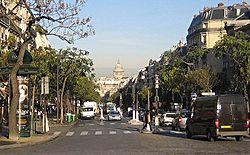
Place de l'Étoile
The Place Charles de Gaulle, , historically known as the Place de l'Étoile , is a large road junction in Paris, France, the meeting point of twelve straight avenues including the Champs-Élysées which continues to the east. It was renamed in 1970 following the death of General and President Charles...
.
Other lines, such as the avenue Daumesnil and the boulevard Malesherbes, enabled access to the centre from the outside arrondissements.
The squares at the crossroads
The connection between the great boulevards required the creation of squares on the same scale. The ChâteletPlace du Châtelet
The Place du Châtelet is a public square in Paris, on the right bank of the river Seine, on the borderline between the 1st and 4th arrondissements...
, converted by Davioud, is the crossroads of the two great axes crossing Paris from north to south and east to west. The works of Haussmann converted other great squares at crossing points across the whole city: Place de l'Étoile
Place de l'Étoile
The Place Charles de Gaulle, , historically known as the Place de l'Étoile , is a large road junction in Paris, France, the meeting point of twelve straight avenues including the Champs-Élysées which continues to the east. It was renamed in 1970 following the death of General and President Charles...
, Place Léon-Blum, Place de la République
Place de la République
The Place de la République is a square in Paris, located on the border between the 3rd, 10th and 11th arrondissements. It is named after the French Republic. The Métro station of République lies beneath the square.-History:...
, Place de l'Alma.
The railway stations
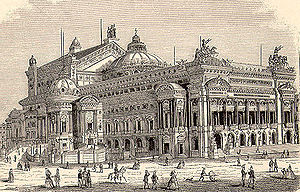
Paris-Gare de Lyon
Paris Lyon is one of the six large railway termini in Paris, France. It is the northern terminus of the Paris–Marseille railway. It is named after the city of Lyon, a stop for many long-distance trains departing here, most en route to the south of France. In general the station's SNCF services run...
reconstructed in 1855 and the Gare du Nord
Gare du Nord
Paris Nord is one of the six large terminus railway stations of the SNCF mainline network for Paris, France. It offers connections with several urban transportation lines, including Paris Métro and RER...
in 1865.
He dreamed of connecting the Parisian railway termini with rail links but had to be content with making access easy by connecting them with important roads. From the Gare de Lyon, the Rue de Lyon, the Boulevard Richard-Lenoir
Boulevard Richard-Lenoir
Boulevard Richard-Lenoir, running from the Bastille to the Avenue de la République, is one of the wide tree-lined boulevards driven through Paris during the Second French Empire by Baron Haussmann, who retained the complete confidence of Napoleon III....
and the Boulevard de Magenta
Boulevard de Magenta
The boulevard de Magenta is located in the IX and X arrondissements of Paris, in France.It begins at place de la République and 1, rue Beaurepaire, and ends at 1, boulevard de Rochechouart and 53, boulevard de la Chapelle.-Etymology:...
run to the Gare de l'Est
Gare de l'Est
is one of the six large SNCF termini in Paris. It is in the 10th arrondissement, not far from the Gare du Nord, facing the Boulevard de Strasbourg, part of the north-south axis of Paris created by Baron Haussmann...
. Two parallel axes (Rue La Fayette and Boulevard Haussmann is the first, Rue de Châteaudun and Rue de Maubeuge the second) join the district around the Gare de l'Est and the Gare du Nord to that of the Gare Saint-Lazare
Gare Saint-Lazare
Paris Saint-Lazare is one of the six large terminus train stations of Paris. It is the second busiest in Paris, behind the Gare du Nord, handling 274,000 passengers each day.-History:...
. On the Left Bank, the Rue de Rennes serves Gare Montparnasse
Gare Montparnasse
Paris Montparnasse is one of the six large terminus railway stations of Paris, located in the Montparnasse area in the XIVe arrondissement. The station was opened in 1840, and rebuilt completely in 1969...
, then situated where the Tour Montparnasse
Tour Montparnasse
Tour Maine-Montparnasse , also commonly named Tour Montparnasse, is a tall office skyscraper located in Paris, France, in the area of Montparnasse. Constructed from 1969 to 1972, it was the tallest skyscraper in France until 2011, when it was surpassed in height by the Tour First...
stands today.
Monuments
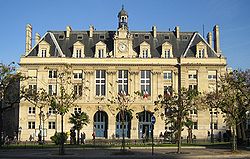
Charles Garnier (architect)
Charles Garnier was a French architect, perhaps best known as the architect of the Palais Garnier and the Opéra de Monte-Carlo.-Early life:...
constructed the Opéra Garnier in an eclectic
Eclecticism
Eclecticism is a conceptual approach that does not hold rigidly to a single paradigm or set of assumptions, but instead draws upon multiple theories, styles, or ideas to gain complementary insights into a subject, or applies different theories in particular cases.It can sometimes seem inelegant or...
style and Gabriel Davioud
Gabriel Davioud
Jean-Antoine-Gabriel Davioud was a French architect.Davioud was born in Paris and studied at the École des Beaux-Arts under Léon Vaudoyer...
designed two symmetric theatres on the Place du Châtelet
Place du Châtelet
The Place du Châtelet is a public square in Paris, on the right bank of the river Seine, on the borderline between the 1st and 4th arrondissements...
. L'Hôtel-Dieu, the prison of the Cité (and future police headquarters), and the tribunal of Commerce replaced the medieval districts on the Île de la Cité. Each of the twenty new local government districts (arrondissements) was given a town hall.
They took care to set these monuments in the town by creating vast perspectives. For example, the Avenue de l'Opéra
Avenue de l'Opéra
The Avenue de l'Opéra is a Haussmanian avenue situated in the centre of Paris, France. It runs from the Louvre to the Palais Garnier, which was Paris's main opera until it was replaced by the Opéra Bastillein 1989....
offers a great frame for the edifice of the Opera Garnier, while the houses that prevented contemplation of the cathedral of Notre-Dame
Notre Dame de Paris
Notre Dame de Paris , also known as Notre Dame Cathedral, is a Gothic, Roman Catholic cathedral on the eastern half of the Île de la Cité in the fourth arrondissement of Paris, France. It is the cathedral of the Catholic Archdiocese of Paris: that is, it is the church that contains the cathedra of...
gave way to a great open space.
Modern public facilities
The renovation of Paris was meant to be total. Cleaning up living areas implied not only a better air circulation but also better provision of water and better evacuation of waste.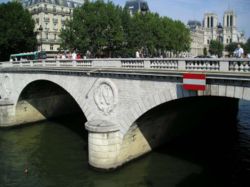
Ourcq
The Ourcq is a 87 km long river in France, right tributary of the Marne. Its source is near the village Ronchères. Its course crosses the departments of Aisne, Oise and Seine-et-Marne. It flows southwest through the towns of Fère-en-Tardenois, La Ferté-Milon, Mareuil-sur-Ourcq and Crouy-sur-Ourcq,...
, a tributary of the Marne
Marne
Marne is a department in north-eastern France named after the river Marne which flows through the department. The prefecture of Marne is Châlons-en-Champagne...
. Steam engines also extracted water from the Seine
Seine
The Seine is a -long river and an important commercial waterway within the Paris Basin in the north of France. It rises at Saint-Seine near Dijon in northeastern France in the Langres plateau, flowing through Paris and into the English Channel at Le Havre . It is navigable by ocean-going vessels...
, but the hygiene was appalling. Haussmann tasked the engineer Belgrand
Eugène Belgrand
Eugène Belgrand was a French engineer who made significant contributions to the modernization of the Parisian sewer system during the 19th century rebuilding of Paris. Much of Belgrand's work remains in use today.-Civil engineering:...
with the creation of a new system of water provision to the capital, which lead to the construction of 600 kilometres of aqueduct
Aqueduct
An aqueduct is a water supply or navigable channel constructed to convey water. In modern engineering, the term is used for any system of pipes, ditches, canals, tunnels, and other structures used for this purpose....
between 1865 and 1900. The first, that of the Dhuis, brought water extracted near Château-Thierry
Château-Thierry
Château-Thierry is a commune in northern France about east-northeast of Paris. It is a sub-prefecture of the Aisne department in Picardy.-History:...
. These aqueducts discharged their water in reservoirs situated within the city. Inside the city limits and opposite Parc Montsouris, Belgrand built the largest water reservoir in the world to hold the water from the River Vanne
Vanne
Vanne is a commune in the Haute-Saône department in the region of Franche-Comté in eastern France.-References:*...
.
Green spaces
Green spaces in Paris were rare. Having visited and enjoyed the beautiful and plentiful London parks, Napoléon III hired engineer Jean-Charles AlphandJean-Charles Alphand
Jean-Charles Adolphe Alphand, born in 1817 and died in 1891, interred at Père Lachaise Cemetery , was a French Engineer of the Corps of Bridges and Roads...
, Haussmann's future successor, to create expansive parks and green spaces. On the east and west borders of the city, you could find the bois de Vincennes
Bois de Vincennes
The Bois de Vincennes is a park in the English landscape manner to the east of Paris. The park is named after the nearby town of Vincennes....
and the bois de Boulogne
Bois de Boulogne
The Bois de Boulogne is a park located along the western edge of the 16th arrondissement of Paris, near the suburb of Boulogne-Billancourt and Neuilly-sur-Seine...
, respectively. In the enceinte de Thiers, the Parc des Buttes Chaumont, the parc Monceau
Parc Monceau
Parc Monceau is a semi-public park situated in the 8th arrondissement of Paris, France, at the junction of Boulevard de Courcelles, Rue de Prony and Rue Georges Berger. At the main entrance is a rotunda. The park covers an area of 8.2 hectares ....
, and the parc Montsouris offered citizens beautiful scenery and a place to relax and be with nature. Also, in each district squares were built, and trees were planted along avenues.
Paris expands

Arrondissements of Paris
The city of Paris is divided into twenty arrondissements municipaux administrative districts, more simply referred to as arrondissements . These are not to be confused with departmental arrondissements, which subdivide the 101 French départements...
.
Critics of Napoleon III's urban politics
Artists and architects (Charles Garnier) deplored the suffocating monotony of monumental architecture. Politicians and writers accused the spread of speculation and corruption (Émile ZolaÉmile Zola
Émile François Zola was a French writer, the most important exemplar of the literary school of naturalism and an important contributor to the development of theatrical naturalism...
's "La Curée" ) and a few accused Haussmann of personal enrichment. Many of the criticisms targeted the base motivations of the venture and ended by felling the préfet.
Widening of streets: a tool for an authoritarian regime?

Lewis Mumford
Lewis Mumford was an American historian, philosopher of technology, and influential literary critic. Particularly noted for his study of cities and urban architecture, he had a broad career as a writer...
's writings.
The extent of the work itself shows that Napoleon III's aims were, at least, not solely security-oriented in nature. Beyond the spectacular piercing of the main boulevards, city transformations also included the construction of a modern underground network of sewers and freshwater, the installation of an efficient building plan on the surface, and the harmonisation of the architecture along the new avenues.
Yet it is true that Napoleon III was concerned with maintaining strict order. Haussmann never hesitated to explain that his street plan would ease the maintenance of public order when presenting his projects to the Conseil de Paris or local landowners. It should also be noted that when reports of the outbreak of the Paris Commune
Paris Commune
The Paris Commune was a government that briefly ruled Paris from March 18 to May 28, 1871. It existed before the split between anarchists and Marxists had taken place, and it is hailed by both groups as the first assumption of power by the working class during the Industrial Revolution...
insurrection reached Haussmann he expressed his frustration at not having been able to carry out his reforms quickly enough to make such an insurrection futile. The strategic dimension is thus indeed present, but it is but one element among others; it is perhaps most important where there was question of joining Paris' main casernes between them.
It should also be mentioned that the police were not one of Haussmann's responsibilities. His mandate actually reduced the position of préfet de police, as it removed from this office problems such as city hygiene and the lighting and cleaning of its streets.
Social rupture
Many contemporary observers denounced the demographic and social effects of Haussmann's urbanism operations.Louis Lazare, author, under Haussmann's predecessor Rambuteau, of an important "dictionary of Paris streets", considered in 1861 in the journal Revue municipale that Haussmann's works disproportionately increased State-dependent populations in attracting masses of poor to Paris. In reality, in certain respects Haussmann himself slowed the progress of his renovations in order to avoid a massive flood of workers to the Capital.
On the other hand, critics denounced as early as 1850 the effect that the renovations would have on the social composition of Paris. In a slightly oversimplified way, they painted a portrait of the pre-Haussmannian building as a synthesis of the Parisian social hierarchy: the bourgeoisie on the second floor, civil servants and employees on the third and fourth, low-wage employees on the fifth, house staff, students and the poor under the eaves. Thus one building was shown to represent and house all social classes. This cohabitation, of course varying from quarter to quarter, disappeared in its majority after the completion of Haussmann's work. This had two effects on the dispersion of dwellings in Paris:
- The city-centre renovations provoked a rise in rents, and this forced poorer families towards Paris' outer arrondissements. This we can see in population statistics:
| Arrondissement | 1861 | 1866 | 1872 |
|---|---|---|---|
| 1er | 89,519 | 81,665 | 74,286 |
| 6e | 95,931 | 99,115 | 90,288 |
| 17e | 75,288 | 93,193 | 101,804 |
| 20e | 70,060 | 87,844 | 92,712 |
- Certain urbanism decisions contributed to a social imbalance between Paris's wealthy west and its underprivileged east. Therefore no eastern neighborhood in Paris benefited from renovations comparable to the large avenues surrounding the place de l'ÉtoilePlace de l'ÉtoileThe Place Charles de Gaulle, , historically known as the Place de l'Étoile , is a large road junction in Paris, France, the meeting point of twelve straight avenues including the Champs-Élysées which continues to the east. It was renamed in 1970 following the death of General and President Charles...
in the XVIe and XVIIe arrondissements. The poor were concentrated in arrondissements left aside by the city renovations.
As an answer to this, Haussmann presented the complex creation of the bois de Vincennes
Bois de Vincennes
The Bois de Vincennes is a park in the English landscape manner to the east of Paris. The park is named after the nearby town of Vincennes....
forest-parklands that would give working populations a promenade comparable to the bois de Boulogne
Bois de Boulogne
The Bois de Boulogne is a park located along the western edge of the 16th arrondissement of Paris, near the suburb of Boulogne-Billancourt and Neuilly-sur-Seine...
. It also must be noted that the unsanitary quarters "cleaned" by Haussmann contained very few of the bourgeois class. Indeed, the parting of uprooting of established working-class residential areas may have been another security measure, as a disrupted and scattered community will find it harder to unite and so will pose less of a threat. To the modern ears this may sound odd, but the working-class people were still known as "the dangerous classes" to Parisians, and the French in general, and the memories of the 1789 and 1848 revolutions, where workers revolted against the state, had left deep impressions on the Parisian psyche.
That way, a sort of "zonage" was established that still dominates the distribution of housing and activities in Paris and its nearest suburbs: from the centre to the west, offices and wealthy neighborhoods; from the east and outer rim, poorer housing and industry.
Financial crisis
The financial system funding the renovations began to fail towards the end of the 1860s. Paris' annexation of its intra-muros suburbs at the beginning of the decade came at a high price: Paris' newer outer quarters required even more renovations than the still-incomplete city centre, and the budgets prepared before the work's onset were proven to be greatly below the mark. Also, a loosening of the regime's more authoritarian aspects made obtaining the necessary expropriations more difficult, as the Conseil d'État (State Council) and Cour de cassationCourt of Cassation (France)
The French Supreme Court of Judicature is France's court of last resort having jurisdiction over all matters triable in the judicial stream but only scope of review to determine a miscarriage of justice or certify a question of law based solely on points of law...
(appeals court) often intervened in favour of landowners.
In addition to the above, Parisians were becoming intolerant of the renovations that had paralysed the city for nearly twenty years. Also, the utility of the network of boulevards in the outer quarters was not as obvious as the piercing of, for example, the boulevard de Sébastopol
Boulevard de Sébastopol
The Boulevard de Sébastopol is an important roadway in Paris, France, which serves to delimit the 1st and 2nd arrondissements from the 3rd and 4th arrondissements of the city....
or the boulevard Saint-Germain
Boulevard Saint-Germain
The Boulevard Saint-Germain is a major street in Paris on the Left Bank of the Seine river. It curves in a 3.5 kilometer arc from the Pont de Sully in the east to the Pont de la Concorde in the west and traverses the 5th, 6th and 7th arrondissements...
.
The journalist Jules Ferry made a name for himself through a series of articles titled "Les Comptes fantastiques d'Haussmann" (or "Haussmann's fantastical accounts (tales)") in which he denounced the exaggerated ambitions of the renovation projects and their uncertain finances. These projects were effectively financed not by loan, but by bonds sold through the Caisse des travaux de Paris (Paris works fund) quite outside of parliament control.
Haussmann was removed from office in the beginning of 1870, a few months before the end of the 2nd Empire
Second French Empire
The Second French Empire or French Empire was the Imperial Bonapartist regime of Napoleon III from 1852 to 1870, between the Second Republic and the Third Republic, in France.-Rule of Napoleon III:...
he had served for almost its entire duration. The debts incurred were quickly absorbed by the government of the 3rd Republic.
Aesthetics of the "Street-Wall"
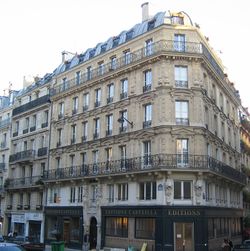
Street block
City block
A city block, urban block or simply block is a central element of urban planning and urban design. A city block is the smallest area that is surrounded by streets. City blocks are the space for buildings within the street pattern of a city, they form the basic unit of a city's urban fabric...
s are designed as homogeneous architectural wholes. Buildings are not treated as independent structures, but together must create – on a block, if not the same street or even quarter
Quarter (country subdivision)
A quarter is a section of an urban settlement.Its borders can be administratively chosen , and it may have its own administrative structure...
– a unified urban landscape.
The regulations and constraints imposed by the authorities favoured a typology that brings the classical evolution of the Parisian building to its term in the façade typical of the Haussmann era:
- ground floor and basement with thick, usually street-lateral, load-bearing walls;
- second, "noble" floor with one or two balconies;
- third and fourth floors in the same style but with less elaborate stonework around the windows;
- fifth floor with a single, continuous, undecorated balcony;
- eaves angled at 45º.
The Haussmann façade is organised around horizontal lines that often continue from one building to the next: balconies and cornice
Cornice
Cornice molding is generally any horizontal decorative molding that crowns any building or furniture element: the cornice over a door or window, for instance, or the cornice around the edge of a pedestal. A simple cornice may be formed just with a crown molding.The function of the projecting...
s are perfectly aligned without any noticeable alcoves or projections. At the risk of the uniformity of certain quarters, the rue de Rivoli served as a model for the entire network of new Parisian boulevards. For the building façades, the technological progress of stone sawing and (steam) transportation allowed the use of massive stone blocks instead of simple stone facing. The street-side result was a "monumental" effect that exempted buildings from a dependence on decoration; sculpture and other elaborate stonework would not become widespread until the end of the century.
Legacy
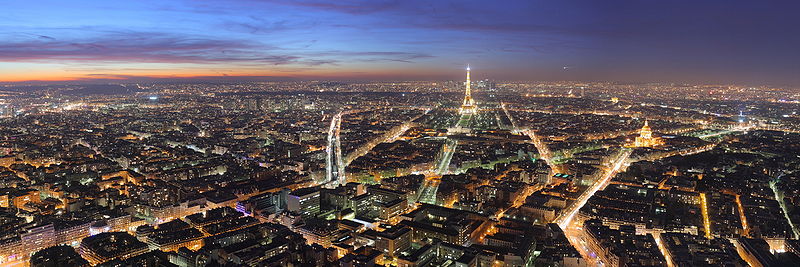
The Second Empire
Second French Empire
The Second French Empire or French Empire was the Imperial Bonapartist regime of Napoleon III from 1852 to 1870, between the Second Republic and the Third Republic, in France.-Rule of Napoleon III:...
renovations left such a mark on Paris' urban history that all subsequent trends and influences were forced to refer to, adapt to, or reject, or to reuse some of its elements. By intervening only once on Paris's ancient districts, pockets of insalubrity remained which explain the resurgence of both hygienic ideals and radicalness of some planners in the 20th century.
The end of "pure Haussmannism" can be traced to urban legislation of 1882 and 1884 that broke with the uniformity of the classical street, in permitting staggered facades and the first creativity for roof-level architecture; the latter would develop greatly after restrictions were further loosened in a 1902 law. All the same, this period was merely "post-Haussmann", rejecting only the austerity of the Napoleon-era architecture, without calling into question the urban planning itself.
A century after Napoleon III's reign, new housing needs and the rise of a new voluntarist Fifth Republic
French Fifth Republic
The Fifth Republic is the fifth and current republican constitution of France, introduced on 4 October 1958. The Fifth Republic emerged from the collapse of the French Fourth Republic, replacing the prior parliamentary government with a semi-presidential system...
opened a new era of Parisian urbanism. The new era rejected Haussmannian ideas as a whole to embrace those represented by architects such as Le Corbusier
Le Corbusier
Charles-Édouard Jeanneret, better known as Le Corbusier , was a Swiss-born French architect, designer, urbanist, writer and painter, famous for being one of the pioneers of what now is called modern architecture. He was born in Switzerland and became a French citizen in 1930...
in abandoning unbroken street-side facades, limitations in building size and dimension, and even closing the street itself to automobiles with the creation of separated, car-free spaces between the buildings for pedestrians. This new model was quickly brought into question by the 1970s, a period marked a rediscovery of the Haussmann heritage: a new promotion of the multifunctional street was accompanied by limitations in the building model and, in certain quarters, by an attempt to rediscover the architectural homogeneity of the Second Empire
Second French Empire
The Second French Empire or French Empire was the Imperial Bonapartist regime of Napoleon III from 1852 to 1870, between the Second Republic and the Third Republic, in France.-Rule of Napoleon III:...
street-block.
The Parisian public today holds a positive view of the Haussmann legacy, to the extent that certain suburban towns, for example Issy-les-Moulineaux
Issy-les-Moulineaux
Issy-les-Moulineaux is a commune in the southwestern suburban area of Paris, France. It is located from the centre of Paris. On 1 January 2003, Issy-les-Moulineaux became part of the Communauté d'agglomération Arc de Seine along with the other communes of Chaville, Meudon, Vanves and Ville-d'Avray...
and Puteaux
Puteaux
Puteaux is a commune in the western suburbs of Paris, France. It is located in the heart of the Hauts-de-Seine department from the center of Paris....
, have built new quarters that even in their name claim "Quartier Haussmannian", the Haussmanian heritage. These quarters are, in reality, but a pastiche of early 20th-century post-Haussmann architecture, with its bow window
Bow window
A bow window is a curved bay window. Bow windows are designed to create space by projecting beyond the exterior wall of a building, and to provide a wider view of the garden or street outside and typically combine four or more casement windows, which join together to form an arch.Bow windows first...
s and loggia
Loggia
Loggia is the name given to an architectural feature, originally of Minoan design. They are often a gallery or corridor at ground level, sometimes higher, on the facade of a building and open to the air on one side, where it is supported by columns or pierced openings in the wall...
s.

